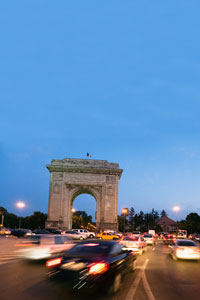There’s something decidedly melancholy about Bucharest’s turbulent history. Once lauded for the leafy boulevards and extravagant classicism that made it a dreamy, romantic city, scandalous reconstruction projects under post-war communist rule saw the large scale destruction of much of its heritage in favour of modern ostentation.
What remains is a fascinating, mismatched collage of twentieth century eclecticism and French-imitation imposed upon a refined canvas of Bauhaus, Art Deco and Neoclassical forms. The spontaneity and variety of the cityscape, not to mention a lively student population, has inspired a similarly fascinating cultural scene; from foreign-language films to international hip-hop, Bucharest serves a vast tasting menu of diverse arts from around the world. There’s plenty of originality here too, with traditional influences particularly notable in the unique brand of music.
Where to stay
The Bucharest Novotel has a prime central location and offers everything you’re likely to need for your visit. The rooms at the Rembrandt are both beautifully understated and well furnished and it has the best of Bucharest on its doorstep.
Where to eat
The best Romanian cuisine is served at La Mama, which also has a fabulous outdoor terrace. Carul cu Bere also has a good local menu and is housed in a stunning cross between a Byzantine church and a bierkeller. Trattoria Il Calcio has a more international flavour but the superb French-Italian food is popular with the local elite.
What to see
Part of Ceauşescu’s communist building reforms, the impressive Palace of Parliament is the second largest building in the world, after the Pentagon. Contrast to the Old Centre, which largely escaped the reforms, and remains a romantic testament to the city in its heyday. The Village Museum, which contains 272 authentic buildings and peasant farms from all over Romania, was 1996 European Musuem of the Year.





